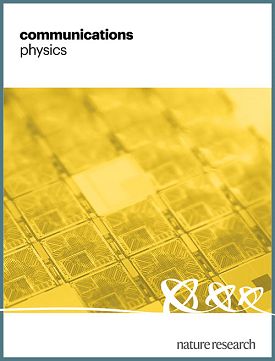揭示重力在振动颗粒介质中形成入侵者动力学中的作用
IF 5.8
1区 物理与天体物理
Q1 PHYSICS, MULTIDISCIPLINARY
引用次数: 0
摘要
我们在中国空间站上的实验揭示了振动颗粒介质中入侵者动力学的重力驱动转变。虽然振动通常使入侵者能够在颗粒床中上升,但低重力条件会使其在类似的振动下下降。使用霍尔传感器阵列跟踪方法,我们在每个振动周期内监测入侵者的运动,并确定了两种竞争机制:惯性和重力依赖穿透。随着重力的减小,我们观察到标度阻尼系数和静水压力系数显著降低,这表明床层颗粒在入侵者撞击时更容易分散,有利于更深的渗透。我们的研究结果强调,当振动加速度超过一个阈值时,入侵者从向下运动到向上运动的关键转变,随着重力的减少,加速度增加。这些关于低重力环境下入侵者动力学的见解对小行星探索和月球基地建设具有重要意义,增强了我们对巴西坚果效应和小行星形成的理解。颗粒分离可能在形成小行星等小天体的表面特征方面发挥作用,这可以用巴西坚果效应来解释。作者研究了中国空间站上颗粒介质中的入侵者动力学,发现与地球上发生的情况相反,入侵者在特定振动参数下的微重力条件下倾向于下降本文章由计算机程序翻译,如有差异,请以英文原文为准。

Unraveling the role of gravity in shaping intruder dynamics within vibrated granular media
Our experiments aboard the Chinese Space Station reveal a gravity-driven transition in intruder dynamics within vibrated granular media. While vibrations typically enable an intruder to ascend in a granular bed, low-gravity conditions induce it to descend under similar vibrations. Using a Hall-sensor array tracking method, we monitor the intruder’s movement throughout each vibration cycle and identified two competing mechanisms: inertia and gravity-dependent penetration. As gravity decreases, we observe a significant reduction in the scaled damping coefficient and hydrostatic pressure coefficient indicating that bed particles disperse more readily upon intruder impact, facilitating deeper penetration. Our findings highlight a critical transition from downward to upward motion of the intruder as vibration acceleration exceeds a threshold, which increases as gravity decreases. These insights into intruder dynamics in low-gravity environments have significant implications for asteroid exploration and lunar base construction, enhancing our understanding of the Brazil nut effect and the formation of planetesimal. Granular segregation may play a role in shaping the surface features of small celestial bodies such as asteroids that can be explained with the Brazil-nut effect. The authors study intruder dynamics in granular media on board the Chinese Space Station, finding that contrary to what occurs on Earth intruders tend to descend in microgravity conditions under specific vibration parameters
求助全文
通过发布文献求助,成功后即可免费获取论文全文。
去求助
来源期刊

Communications Physics
Physics and Astronomy-General Physics and Astronomy
CiteScore
8.40
自引率
3.60%
发文量
276
审稿时长
13 weeks
期刊介绍:
Communications Physics is an open access journal from Nature Research publishing high-quality research, reviews and commentary in all areas of the physical sciences. Research papers published by the journal represent significant advances bringing new insight to a specialized area of research in physics. We also aim to provide a community forum for issues of importance to all physicists, regardless of sub-discipline.
The scope of the journal covers all areas of experimental, applied, fundamental, and interdisciplinary physical sciences. Primary research published in Communications Physics includes novel experimental results, new techniques or computational methods that may influence the work of others in the sub-discipline. We also consider submissions from adjacent research fields where the central advance of the study is of interest to physicists, for example material sciences, physical chemistry and technologies.
 求助内容:
求助内容: 应助结果提醒方式:
应助结果提醒方式:


